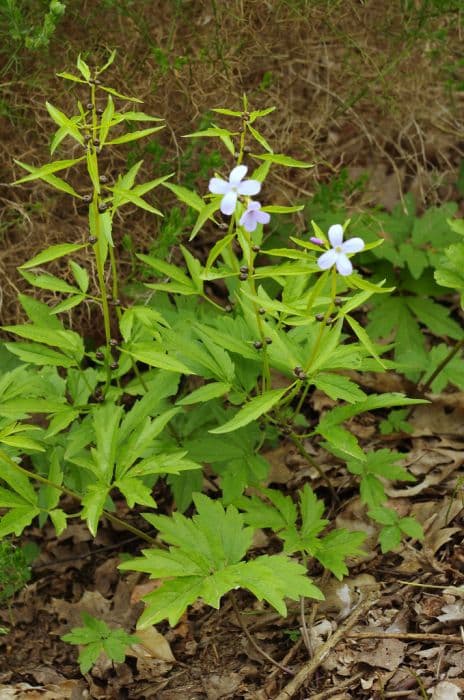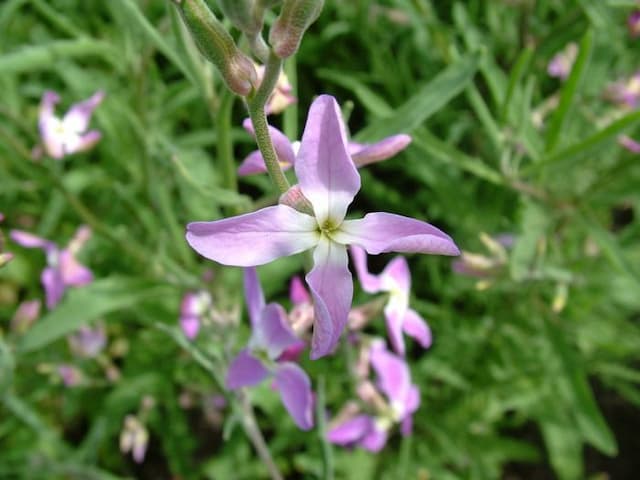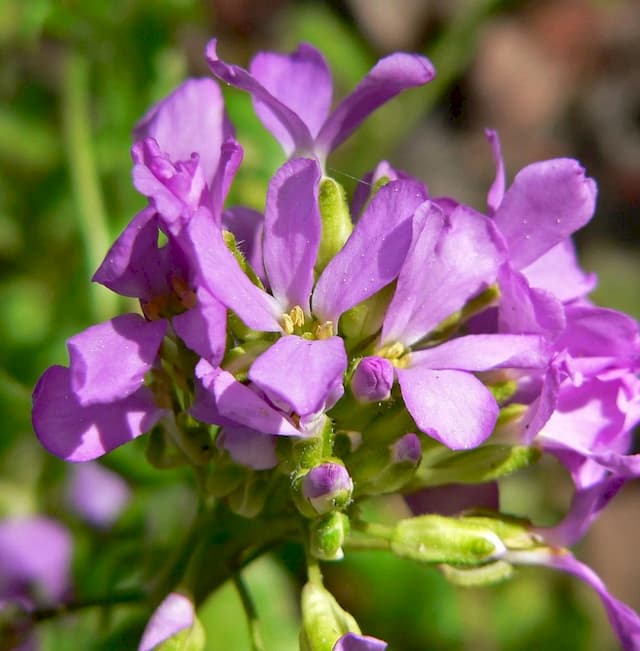Rock cress Aubrieta gracilis 'Kitte Rose'

ABOUT
Aubrieta gracilis 'Kitte Rose', commonly known as the rock cress, is a charming perennial plant that's highly appreciated for its ornamental value. This variety is known for its profusion of small, dainty flowers that create a vibrant display. The flowers of the 'Kitte Rose' are a delightful shade of pink, exhibiting a soft and inviting hue that adds a splash of color to garden landscapes. These blooms are typically arranged in small clusters, which together create a tapestry-like effect when in full bloom. The foliage of the rock cress is lush and compact, forming a dense mat of small leaves. The leaves themselves are oval to spoon-shaped, with a slightly hairy texture, lending the plant a soft, almost velvety appearance to the touch. Their color is a rich green, setting an attractive background that makes the pink flowers stand out even more. Rock cress generally has a cascading habit, making it an ideal choice for rock gardens, wall crevices, or as edging plants, where its trailing foliage can spill over edges gracefully. The overall visual impression it gives is one of a floral carpet that enhances the visual appeal of wherever it grows. The contrast between the delicate pink flowers and lush green foliage typically makes it a popular choice for gardeners looking to create a tapestry of ground cover with a burst of spring color.
About this plant
 Names
NamesFamily
Brassicaceae
Synonyms
Rock Cress, False Rockcress, Rainbow Rock Cress
Common names
Aubrieta gracilis 'Kitte Rose'.
 Toxicity
ToxicityTo humans
Rock cress is not known to be toxic to humans. Consequently, ingestion of parts of the rock cress plant typically does not lead to poisoning or the associated symptoms.
To pets
Rock cress is generally considered non-toxic to pets. It is not associated with causing poisoning in animals, so ingestion of parts of the rock cress plant is not expected to result in any adverse symptoms.
 Characteristics
CharacteristicsLife cycle
Perennials
Foliage type
Evergreen
Color of leaves
Green
Flower color
Pink
Height
4 inches (10 cm)
Spread
18 inches (45 cm)
Plant type
Herb
Hardiness zones
4
Native area
Europe
Benefits
 General Benefits
General Benefits- Low Maintenance: Aubrieta gracilis 'Kitte Rose' is known for being a low-maintenance plant, requiring minimal care once established in the garden.
- Ground Cover: Its dense mat-like growth habit makes it an excellent ground cover, suppressing weeds and preventing soil erosion.
- Drought Tolerant: Once established, this plant is drought-tolerant, making it ideal for rock gardens and dry, sunny areas.
- Attracts Pollinators: The flowers attract bees, butterflies, and other pollinating insects, supporting local ecosystems.
- Spring Color: With its bright rose-pink flowers, this plant adds vibrant color to the garden in spring, enlivening the landscape after winter.
- Cold Hardy: It is tolerant of cold temperatures and can thrive in many climates, making it versatile for various garden zones.
- Rock Garden Suitable: The plant's compact growth and ability to thrive in rocky, poor soil make it ideal for use in rock gardens and alpine settings.
- Border Edging: Its low-growing nature is perfect for creating defined edges along borders and walkways.
- Long Blooming: Aubrieta delivers a long blooming period, providing extended interest and color in the garden.
- Versatile Use: It can be used in containers, over walls, or in mixed perennial beds, offering flexibility in garden design.
 Medical Properties
Medical PropertiesThis plant is not used for medical purposes.
 Air-purifying Qualities
Air-purifying QualitiesThis plant is not specifically known for air purifying qualities.
 Other Uses
Other Uses- Aubrieta gracilis, commonly known as Rock Cress, can be used to create a natural dye. The leaves and flowers may produce varying shades of yellow to green hues when used in the dyeing process.
- Rock Cress works as an effective ground cover to prevent soil erosion on slopes or in areas where other plants struggle to thrive.
- The dense mat formed by Aubrieta gracilis can be utilized in garden designs to outline paths, accentuate rockeries, or define the edges of garden beds.
- Rock Cress can serve as an indicator plant for gardens, as its preference for well-drained soil helps gardeners identify areas that may need improved drainage.
- Owing to its compact growth, Rock Cress is suitable for planting in cracks between paving stones, offering an aesthetic solution to weed prevention.
- In mild climates, Rock Cress can be grown as an evergreen addition, providing year-round greenery in a garden setting.
- Aubrieta gracilis can be planted on green roofs, where its tolerance for dry conditions and low maintenance requirements make it an ideal choice.
- Rock Cress, being alpine in origin, can be used in educational gardens to demonstrate the types of plants that thrive in mountainous environments.
- The cascading habit of Aubrieta gracilis makes it a suitable choice for spilling over walls or containers, adding texture and depth to vertical gardening.
- When strategically placed, Rock Cress can attract beneficial insects, such as bees and butterflies, which are essential for pollination in gardens.
Interesting Facts
 Feng Shui
Feng ShuiThe Aubrieta is not used in Feng Shui practice.
 Zodiac Sign Compitability
Zodiac Sign CompitabilityThe Aubrieta is not used in astrology practice.
 Plant Symbolism
Plant Symbolism- Determination: Aubrieta, also known as rock cress, often grows in rocky, alpine regions, symbolizing resilience and the ability to thrive in challenging conditions.
- Survival: Its ability to survive with minimal soil and moisture reflects the symbolic meaning of survival against the odds.
- Beauty in Simplicity: The simple yet vibrant flowers of the rock cress represent finding beauty in simplicity and the uncomplicated aspects of life.
- Grounding: As a ground-cover plant, rock cress represents grounding and stability, reminding us to stay connected with our foundation and the earth.
 Water
WaterFor the Rock Cress, it's essential to ensure the soil is evenly moist, especially during the spring and early summer when the plant is actively growing. Water the plant thoroughly when the top inch of the soil feels dry to the touch, which typically means around once a week, but this can vary depending on climate and weather conditions. Aim to provide between one to two gallons of water every two weeks, adjusting as necessary for rainfall and temperature variations to avoid overwatering.
 Light
LightRock Cress prefers full sun to partial shade, so the best spot for the plant is where it will receive at least six hours of sunlight daily. It will tolerate some light shade, especially in regions with very hot summers, but too much shade may lead to sparse blooms and a leggy growth habit.
 Temperature
TemperatureRock Cress thrives in a temperature range from approximately 60°F to 75°F but can survive in temperatures as low as 20°F and as high as 85°F. To encourage optimal growth and flowering, maintain the garden area within this ideal temperature range, avoiding the extremes which could stress the plant.
 Pruning
PruningRock Cress should be pruned to encourage a compact growth form and to rejuvenate the plant for the following season. The best time to prune is right after it finishes blooming, usually in late spring to early summer. Remove any spent flowers and lightly shape the plant, but avoid heavy pruning which may damage the plant. Pruning once a year is typically enough to maintain its shape and vigor.
 Cleaning
CleaningAs needed
 Soil
SoilRock cress requires well-draining soil with sharp sand or gravel mixed in to improve drainage. The best soil pH for Aubrieta gracilis 'Kitte Rose' is slightly alkaline, around 6.5 to 7.5. A typical mixture could be composed of garden soil, compost, and coarse sand in equal parts to ensure nutrients and proper drainage.
 Repotting
RepottingThe rock cress plant, like Aubrieta gracilis 'Kitte Rose', is a low-maintenance plant that generally does not require frequent repotting and can thrive in the same container for several years. Repotting every 3-4 years can be sufficient unless the plant outgrows its container sooner or the soil needs refreshing.
 Humidity & Misting
Humidity & MistingRock cress prefers a moderate level of humidity but is quite adaptable and can tolerate dry conditions well. It is important to avoid high humidity environments as they can promote fungal diseases. Aim for average room humidity or outdoor conditions with good air circulation.
 Suitable locations
Suitable locationsIndoor
Place rock cress in bright indirect light and cooler temps.
Outdoor
Grow in full sun with well-drained soil and space plants.
Hardiness zone
4-9 USDA
 Life cycle
Life cycleAubrieta gracilis 'Kitte Rose', commonly known as Rock Cress, typically begins its life cycle when seeds are sown in fertile, well-draining soil, either in autumn or early spring. The seeds germinate, emerging as seedlings, which will establish a root system and a small rosette of leaves. As the plant enters its vegetative stage, it develops a mat-forming habit with numerous shoots, and the foliage begins to spread outwards. During its flowering stage, usually in mid to late spring, the Rock Cress produces a profusion of small, pink flowers that attract pollinators. Following pollination, the flowers develop into seed pods, which eventually release seeds, thereby allowing the plant to propagate. After flowering, as summer approaches, the plant may enter a dormant phase, particularly in hot climates, but it is a perennial and will resume growth in the following season.
 Propogation
PropogationPropogation time
Spring
For the Aubrieta gracilis, commonly known as Rock Cress 'Kitte Rose', the most popular method of propagation is by taking stem cuttings. This is typically done in late spring or early summer when the plant's growth is vigorous. To propagate, you should choose a healthy stem with several sets of leaves. Cut a 3 to 4-inch-long section of the stem, using a sharp, sterile blade, and strip the lower leaves. The bottom end of the cutting is then dipped in rooting hormone and planted in a well-draining soil mix. Covering the cutting with a plastic bag can create a greenhouse effect, maintaining high humidity, but ensure to open it occasionally to prevent mold. Rooting usually occurs in 2 to 4 weeks, after which the new Rock Cress 'Kitte Rose' plants can be gradually acclimatized to outdoor conditions before transplanting.







![Aubrieta [Axcent Lilac]](/_next/image?url=https%3A%2F%2Fplants-admin.emdemapps.com%2Fimages%2Fplants%2F%2Fimages%2F604b5e2430fac.png&w=640&q=75)
